Tasting History: 10 Damascene sweets that reflect the city's culture
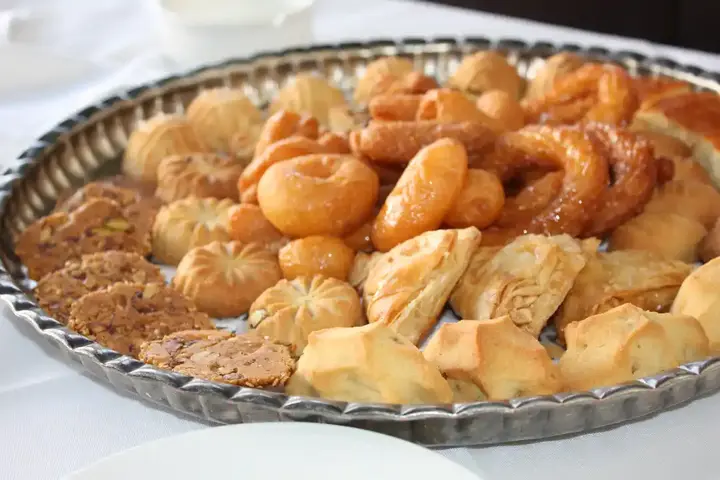
Damascus, the capital of Jasmine, is famous for its rich heritage and ancient culture that extends through the ages, and one of the most prominent manifestations of this heritage is the Damascene sweets, which are an integral part of the Syrian identity. Damascene sweets are characterized by their diversity and richness in flavors that captivate the hearts and attract visitors from all sides. From crispy stools to soft baklava, each piece of this dessert carries a historical and heritage story that reflects the fragrance of the past and the splendor of the present.
Show key points
- Damascene sweets are deeply rooted in Syria’s cultural identity and symbolize the city’s hospitality and heritage.
- These desserts trace their origins back to ancient times, evolving through Roman, Byzantine, and Islamic influences.
- Damascus boasts a wide variety of sweets like barazek, maamoul, and baklava, each telling a unique story tied to tradition.
- ADVERTISEMENT
- Damascene sweets play a central role in religious and social celebrations, often shared during Eid and family gatherings.
- Recipes for these sweets are passed down through generations, preserving both cultural values and culinary artistry.
- Ingredients such as nuts, semolina, sugar, and ghee are commonly used, reflecting both local resources and historical trade routes.
- More than just food, Damascene sweets serve as a living legacy of the city's past, showcasing creativity and communal pride.
In this article, we will travel together on a sweet journey through the alleys of old Damascus, exploring the 10 most delicious Damascene sweets that have always been a source of pride and happiness for their people. We will learn about the stories behind these sweets and how they became a symbol of Damascene generosity and hospitality. Let's start this delicious journey and dive into the irresistible world of Damascene sweets.
Recommend
A brief history of Damascene sweets
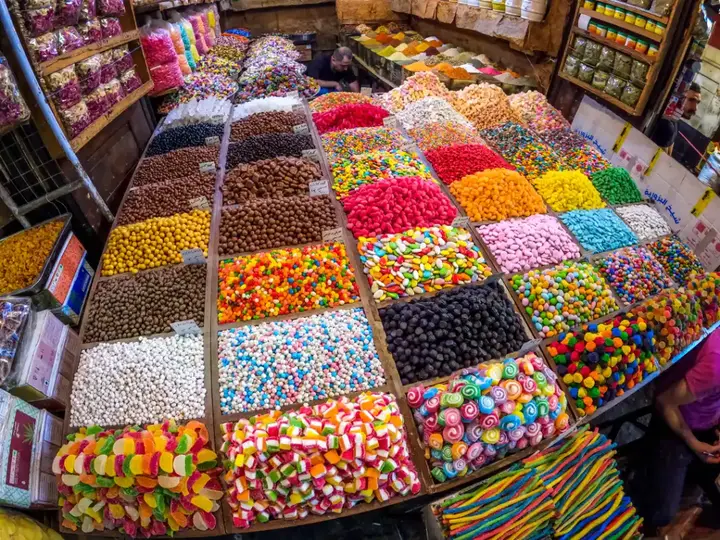
Damascene sweets have their roots in prehistoric times, with archaeological evidence suggesting that the inhabitants of the area made sweets using honey and dried fruit. Over time, the industry evolved to include new ingredients such as sugar and nuts, which were introduced by traders and conquerors from around the world. In Islamic times, Damascus emerged as a center of culture and the arts, sweets were an integral part of hospitality and celebrations, and recipes evolved to become more complex and diverse.
The importance of sweets in Damascene culture

Damascene sweets are not just delicious foods, they are an expression of the cultural and social identity of the people of Damascus. Sweets play an important role in religious and national celebrations and occasions, and are considered a symbol of generosity and hospitality. It also serves as a bridge of communication between generations, where recipes and traditions are passed down from grandparents to grandchildren, preserving Damascus' cultural heritage.
The origins and cultural influences of Damascene sweets
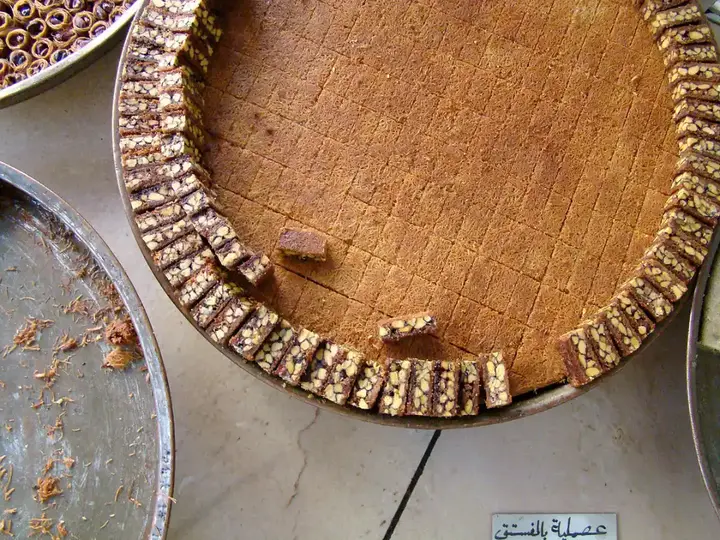
Damascene sweets reflect a long history of cultural and civilizational exchange that the city has witnessed through the ages. From the Roman era, through the Byzantine period to the Islamic era, Damascus received many cultures that influenced its cuisine and sweets. Barazek, for example, are believed to date back to Roman times, where they were made of wheat, sesame and honey, and offered as an offering to the gods.
With the Islamic conquests, Islamic civilization introduced new ingredients such as sugar, nuts and syrup, which became an essential part of the confectionery industry. Damascene desserts were also influenced by Persian and Andalusian cuisine, leading to the development of new recipes and innovative cooking techniques.
Damascene sweets today are the product of this rich heritage, expressing good taste and delicate art in industry, and carrying with them echoes of history and traditions that characterize the city and its people.
Top 10 most famous Damascene sweets
1. Barazek: crispy dessert with sesame
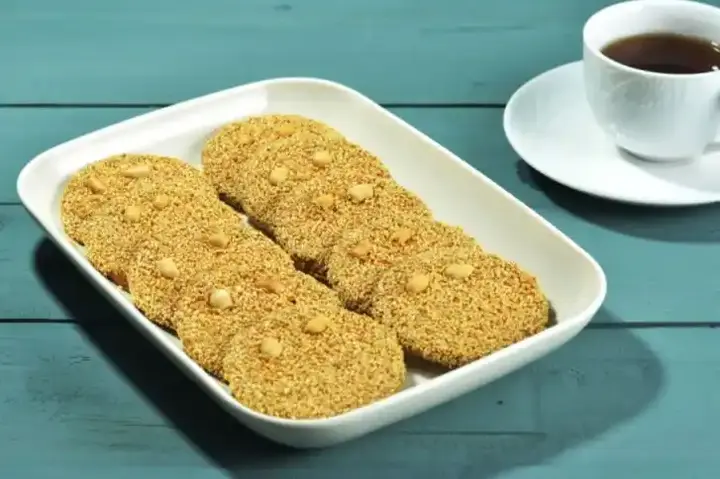
Al-Barazeq, this famous Damascene dessert, is considered one of the oldest and most famous sweets in Syria and the Arab world. It is characterized by its crispy taste and rich flavor of roasted sesame and light diameter that gives it a distinctive sweetness. Barazek's history dates back hundreds of years and carries with it part of Damascus' ancient history.
Ingredients and preparation:
Barazeq is made from a simple dough containing flour, ghee and sugar, and is formed into round discs dipped in toasted sesame before baking. The syrup is added to it immediately after baking to give it shine and sweet taste.
History and Origins:
Barazek is part of Damascene cultural heritage and traditionally presented at ceremonies and special occasions. They express Damascene generosity and hospitality, often served with Arabic coffee or tea.
Barazek is very popular not only in Syria, but in many Arab countries and Arab communities around the world. It is considered a symbol of authenticity and tradition and is sold in many boutiques both traditional and trendy.
2. Maamoul: Fine cakes with dates

Maamoul is one of the most famous Damascene sweets that has a special place in the hearts of Syrians and lovers of Arabic sweets. Maamoul is known as a soft and luxurious cake stuffed with dates, pistachios or walnuts, traditionally served on holidays and religious occasions such as Eid al-Fitr and Eid al-Adha.
Ingredients and preparation: Maamoul is made from a soft dough containing semolina or flour, ghee, and sugar, and is filled with a mixture of dates, cinnamon and mahlab. After filling, maamoul is shaped into different shapes using special molds that give them beautiful and distinctive patterns.
History and origins: It is believed that the maamoul dates back to the Abbasid era, where it was served as food for kings and princes. His fame spread in the Arab world and he became a symbol of hospitality and celebrations.
Maamoul is one of the sweets sold in most bakeries and pastry shops in Damascus and other Arab cities, and is considered one of the indispensable sweets in holidays and occasions.
3. Exotic: soft biscuits with pistachios
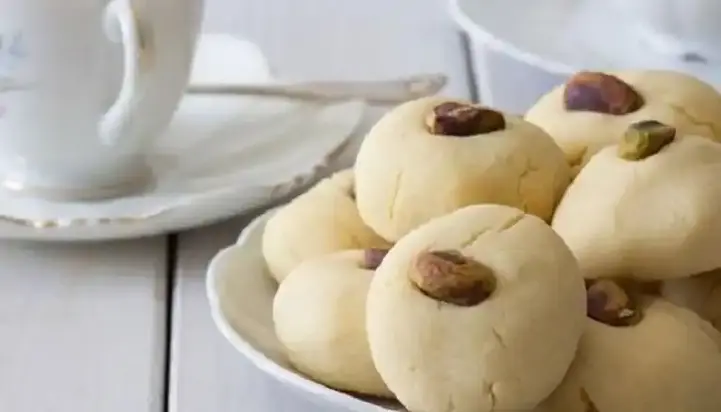
Exotic is one of the traditional Damascene desserts that is distinguished by its unique taste and crisp texture. Ghariba is one of the essential desserts on occasions, especially on Eid al-Fitr, as it is served as a hospitality to visitors and parents.
Ingredients and preparation: The shortbread is made from simple ingredients including flour, ghee, and caster sugar, and sometimes pistachios are added to it to give a distinctive flavor. Mix flour with ghee and sugar until a smooth dough is formed, then form the dough into small balls that are lightly pressed to take their distinctive shape, and decorate each piece with a pistachio.
History and origins: Ghariba is considered one of the sweets that reflect the simplicity and elegance of Damascene cuisine, and it is said that its origins date back to the Ottoman era, where it was made in palaces and ancient houses.
Shortbread is sold in most Damascene pastry shops and is considered one of the favorite gifts of many.
4. Baklava: layers of dough and nuts
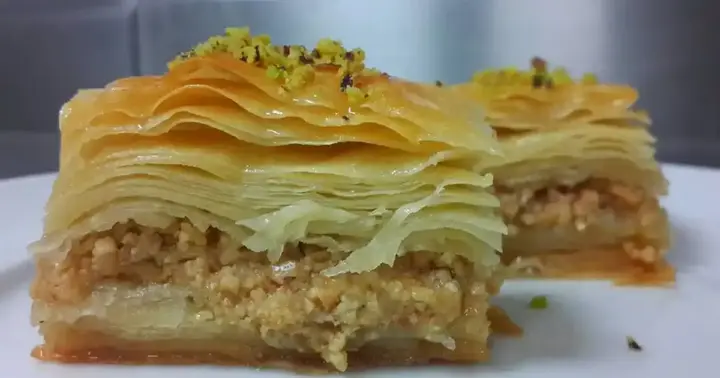
Baklava, this famous dessert that is considered one of the masterpieces of Damascene cuisine, is characterized by its thin and crispy layers of filo dough and its filling rich in nuts and sweet syrup. Baklava is a luxurious dessert served on special occasions and holidays.
Ingredients and preparation: Baklava is made from thin filo dough, which is spread with ghee between each layer and layer, and stuffed with a mixture of chopped nuts such as walnuts or pistachios. After baking, the baklava is watered with syrup to give it sweetness and shine.
History and origins: Baklava is a dessert that reflects the multiple cultural influences experienced by Damascus, as its origins are believed to date back to the Ottoman era. Its fame has spread in the Arab and Mediterranean world, and it has become a symbol of oriental sweets.
Baklava is the perfect gift that expresses the refined taste and appreciation of fine cuisine.
5. Harissa: delicious cake with semolina
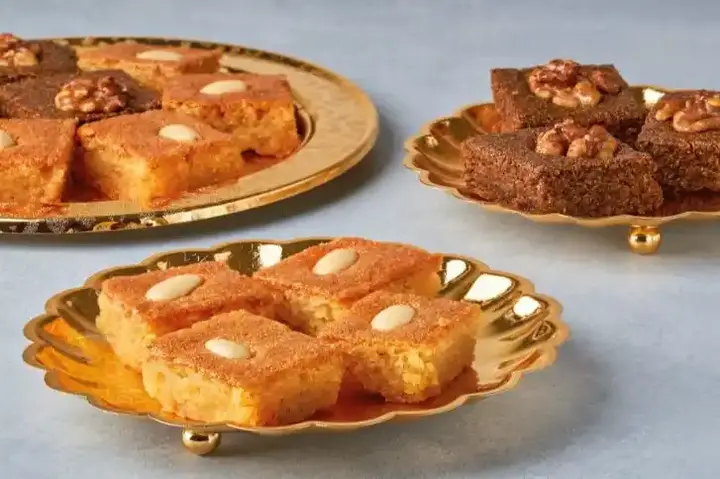
Harissa, also known as basbousa in some Arab countries, is one of the classic Damascene desserts that enjoys great popularity in the region. Usually served as hospitality at family gatherings and social events, it is known for its soft texture and rich taste.
Ingredients and preparation: Harissa is made from semolina, sugar, ghee (or butter), yogurt (or yogurt), and baked until it takes on a beautiful golden color. After baking, water with hot syrup to become moist and delicious. They can be decorated with almonds or pistachios to add flavor and attractive look.
History and origins: Harissa is one of the sweets that express the folklore and simple, and it is considered one of the ancient recipes that are transmitted through generations.
Harissa is one of the beloved sweets in many Arab countries, and is served on various occasions and holidays. It is sold in Damascene pastry shops and is considered one of the dishes that show the skill of the confectioner in preparing traditional sweets.
6. Qatayef: pancakes stuffed with cream

Qatayef is one of the Damascene sweets that is considered a symbol of the month of Ramadan and religious celebrations. Known for its soft texture and rich filling, it is served hot and crispy, making it a favorite dessert.
Ingredients and preparation: Qatayef is made from a special dough similar to pancake dough, and stuffed with cream or nuts as desired. After filling, close the Qatayef in a semicircle and fry or bake until golden. Then dip in syrup or sprinkle with caster sugar.
History and origins: Qatayef is a dessert dating back to the Fatimid era, and it spread in Arab countries and became part of the Ramadan tradition. Qatayef expresses joy and family gathering, and is considered one of the customs that characterize the holy month.
Qatayef is one of the popular sweets sold in Damascene markets and shops, especially in Ramadan.
7. Namura: Dessert moistened with syrup
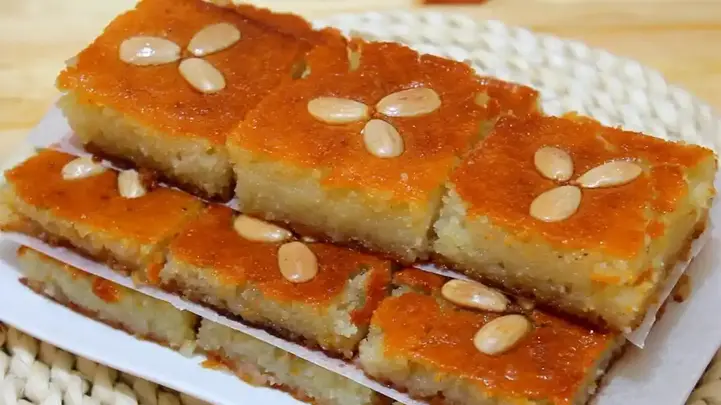
Namura, also known in some areas as basbousa or harissa, is a traditional Damascene dessert characterized by its soft texture and mild sweet taste. Namura is a beloved dessert in many Arab countries and is usually served on special occasions and family gatherings.
Ingredients and preparation: Namoura is made from semolina mixed with sugar, ghee and yogurt, and baked in the oven until it takes on a golden color. After baking, it is watered with hot syrup, which is a mixture of sugar, water and lemon juice, giving it a distinctive moisture and flavor. They can be decorated with almonds or pistachios to add an attractive look and extra flavor.
History and origins: Namura is one of the sweets that reflect the originality and folklore of Damascus. This dessert is part of the collective memory of Damascene society and expresses authenticity and tradition.
8. Kunafa: Golden fabric with cheese

Kunafa is one of the most famous Damascene desserts that is considered one of the most prominent manifestations of hospitality in the region. Known for its crispy golden layers and rich filling with fresh cheese or cream, it is usually served hot with sweet syrup.
Ingredients and preparation: Kunafa is made from thin dough bristles that are spread with ghee and stuffed with fresh Arabic cheese or cream. After baking in the oven until golden, water with hot syrup to make it moist and firm.
History and origins: Kunafa is a dessert dating back to the Ottoman era, and it has spread in Arab countries and has become part of Ramadan traditions and celebrations. Kunafa expresses joy and generosity, and is considered one of the sweets that show Arab generosity.
9. Shuaibiyat: Crispy layers with cream
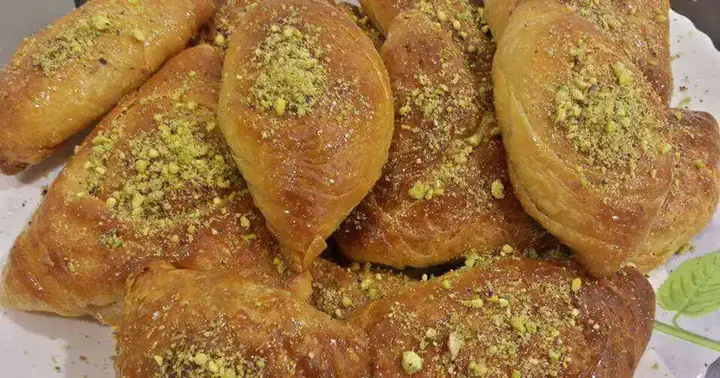
Shuaibiyat is a traditional Damascene dessert characterized by its crispy layers and filling rich in Arabic cream. It is considered a favorite dessert on holidays and occasions, and is usually served as a luxurious hospitality.
Ingredients and preparation: Shuaibiyat is made from filo dough or custom oriental dough, which is cut into squares and then stuffed with fresh cream. Carefully fold the dough into triangles or squares, and bake until golden and crispy. After baking, water with syrup to become moist and delicious.
History and Origins: Shuaibiyat is a dessert that reflects creativity in Damascene cuisine and shows diverse cultural influences. This dessert is part of Syria's food heritage and expresses authenticity and tradition.
Shuaibiyat is a dessert that shows generosity and Arabian hospitality, and is presented as a gift that expresses appreciation and respect.
10. Clasp: candy with syrup

Al-Mashbak is a type of Damascene dessert that is distinguished by its stained shape and distinctive sweet taste. The clip is a traditional dessert served on occasions and celebrations, and is loved by adults and children alike.
Ingredients and preparation: The clip is made from a liquid paste containing flour, starch and water, and fried in hot oil using a special funnel to form overlapping rings. After golden, dip in hot syrup to become moist and delicious.
History and Origins: It is believed that the clip dates back to the Abbasid era, and its fame has spread in the Arab world as a beloved dessert on holidays and occasions. The clip expresses joy and family gathering, and is considered one of the sweets that show Arab generosity.
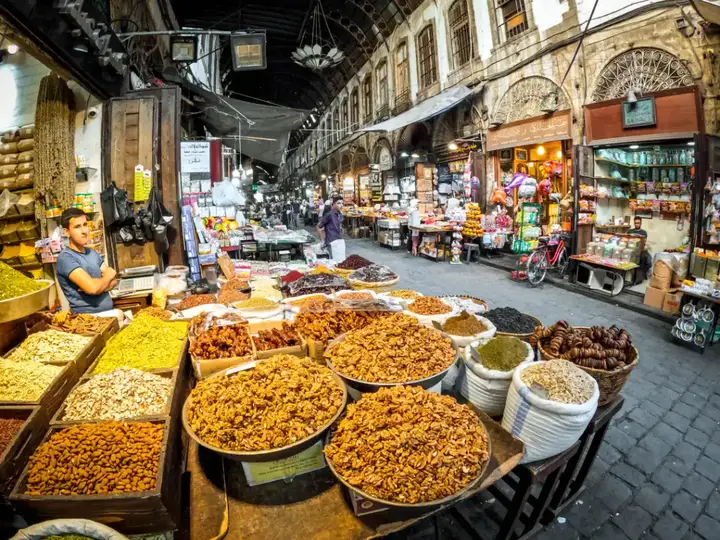
At the end of this article, we can see how Damascene sweets are more than just delicious tastes that seduce the senses; they are an integral part of the cultural and social fabric of the ancient city of Damascus. Each piece of candy carries a story and history that dates back to bygone eras, and expresses the traditions and customs of the people of the city, who are proud of their rich heritage. From crispy barazek to golden kunafa, these sweets are a symbol of Damascene generosity and hospitality, and are served at their weddings and holidays, adding an unforgettable taste to the moments of celebration.
Damascene sweets also showcase the creativity and skill of Syrian cuisine, blending traditional heritage with modern touches that dazzle everyone who tastes them. Thus, these sweets are not just part of everyday cuisine, but are an essential ingredient in private and public occasions, expressing Damascene identity and spirit.
By preserving these sweets and presenting them from generation to generation, the people of Damascus can preserve and share their rich heritage with the world, offering a glimpse into their ancient history and culture full of authenticity and tradition.








